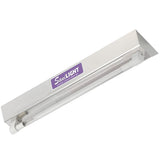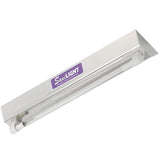How Do Motion Sensors Work? Two Types of Motion Sensors
Posted by Dave on for ProLampSales
Someone once wisecracked that the most energy efficient lighting was when the lights were turned OFF.
A variation of this clever turn of phrase has become one of the most useful tools to increase building lighting energy efficiency. By automatically controlling the ON/OFF status of lights based on the presence of humans in a space, a tremendous amount of energy and money can be saved in commercial buildings.
In addition, for medical settings utilizing germicidal UVC fixtures for air and surface disinfection, a motion sensor can turn the units off if activity is detected. This makes the units safer to operate unattended, since they can automatically turn off the harmful ultraviolet lamps.
Occupancy sensing, commonly called motion sensing, assumes that if there is no motion in a space for a specified length of time the lights should be turned OFF. Human motion, or lack of it, is the logic for determining the status of the lighting.
(For obvious reasons, this logic is reversed in the case of germicidal lighting, but the process is the same: the sensing of human motion determines when the lights turn OFF.)
There are two motion sensing technologies used in lighting controls: passive infrared and ultrasonic. Here is an overview.
Passive Infrared Motion Sensors
Passive infrared (PIR) senses occupancy by detecting differences in heat between humans and the background of the room. The PIR lens divides the room into zones. When the sensor "sees" a change in infrared energy in a zone, it assumes the room is occupied.
When a pre-set time passes with no detected change in infrared energy, then the lights are turned off.
PIR sensors will not work if the line of sight is blocked by shelves, partitions or walls. The best applications are enclosed offices where the sensor can "see" the entire office, in hallways, and small rooms such as laundry or pantry in homes.
The easiest installation of a PIR sensor is as a wall switch replacement.
Ultrasonic Motion Sensors
Ultrasonic occupancy sensors emit sound waves beyond the ability of humans to detect. The sound waves bounce off walls and objects in the room. The sensor measures the time for the waves to go round trip. A timing disruption of the wave pattern, results in a Doppler shift, the logic of the sensor says the space is occupied and the lights remain ON. When a specified period of time passes with no Doppler shift, the lights turn OFF.
Because ultrasonic sensors can bounce sound waves with 360 degree coverage throughout a three dimensional space, they can detect motion around barriers such as workspace partitions, shelves and other obstacles in the room. Ultrasonic sensors also have the ability to detect smaller movements compared to passive infrared sensors.
The best applications are large open office spaces, storage areas with cabinets and shelves and bathrooms.
Dual Technology Motion Sensors
Some spaces present problems for passive infrared sensing or ultrasonic sensing used alone. Dual Technology occupancy sensing combines occupancy sensing strategies into one unit. These units provide very accurate control logic by turning lighting on when both PIR and ultrasonic sensors detect occupancy. When the lights are ON, it requires motion detection from only one sensor to keep them on.
Best applications are classrooms, cafeterias and rooms with very high ceilings.
- Posted in Controls, Energy Efficiency
Featured Products (View All)
0 Comments




